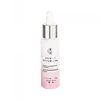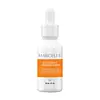What's inside
What's inside
 Key Ingredients
Key Ingredients

 Benefits
Benefits

 Concerns
Concerns

 Ingredients Side-by-side
Ingredients Side-by-side

Water
Skin ConditioningPropylene Glycol
HumectantAlcohol
AntimicrobialDiglycerin
HumectantPentylene Glycol
Skin ConditioningCentaurea Cyanus Flower Water
Skin ConditioningNiacinamide
SmoothingSodium Ascorbyl Phosphate
AntioxidantPolyglyceryl-10 Laurate
Skin ConditioningInositol
HumectantSodium Hyaluronate
Humectant1,2-Hexanediol
Skin ConditioningCaprylyl Glycol
EmollientSodium Citrate
BufferingCitric Acid
BufferingParfum
MaskingLinalool
PerfumingMannan
Sodium Benzoate
MaskingPotassium Sorbate
PreservativeWater, Propylene Glycol, Alcohol, Diglycerin, Pentylene Glycol, Centaurea Cyanus Flower Water, Niacinamide, Sodium Ascorbyl Phosphate, Polyglyceryl-10 Laurate, Inositol, Sodium Hyaluronate, 1,2-Hexanediol, Caprylyl Glycol, Sodium Citrate, Citric Acid, Parfum, Linalool, Mannan, Sodium Benzoate, Potassium Sorbate
Water
Skin Conditioning3-O-Ethyl Ascorbic Acid
Skin ConditioningDimethicone
EmollientPropanediol
SolventGlycerin
HumectantSodium Citrate
BufferingDimethiconol
EmollientCitric Acid
BufferingLactobacillus Ferment
Skin Conditioning1,2-Hexanediol
Skin ConditioningPolyacrylate Crosspolymer-6
Emulsion StabilisingMaltodextrin
AbsorbentHydroxyethyl Acrylate/Sodium Acryloyldimethyl Taurate Copolymer
Emulsion StabilisingSqualane
EmollientSodium Gluconate
Skin ConditioningCaprylhydroxamic Acid
Polysorbate 60
EmulsifyingT-Butyl Alcohol
PerfumingSorbitan Isostearate
EmulsifyingWater, 3-O-Ethyl Ascorbic Acid, Dimethicone, Propanediol, Glycerin, Sodium Citrate, Dimethiconol, Citric Acid, Lactobacillus Ferment, 1,2-Hexanediol, Polyacrylate Crosspolymer-6, Maltodextrin, Hydroxyethyl Acrylate/Sodium Acryloyldimethyl Taurate Copolymer, Squalane, Sodium Gluconate, Caprylhydroxamic Acid, Polysorbate 60, T-Butyl Alcohol, Sorbitan Isostearate
Ingredients Explained
These ingredients are found in both products.
Ingredients higher up in an ingredient list are typically present in a larger amount.
1,2-Hexanediol is a synthetic liquid and another multi-functional powerhouse.
It is a:
- Humectant, drawing moisture into the skin
- Emollient, helping to soften skin
- Solvent, dispersing and stabilizing formulas
- Preservative booster, enhancing the antimicrobial activity of other preservatives
Citric Acid is an alpha hydroxy acid (AHA) naturally found in citrus fruits like oranges, lemons, and limes.
Like other AHAs, citric acid can exfoliate skin by breaking down the bonds that hold dead skin cells together. This helps reveal smoother and brighter skin underneath.
However, this exfoliating effect only happens at high concentrations (20%) which can be hard to find in cosmetic products.
Due to this, citric acid is usually included in small amounts as a pH adjuster. This helps keep products slightly more acidic and compatible with skin's natural pH.
In skincare formulas, citric acid can:
While it can provide some skin benefits, research shows lactic acid and glycolic acid are generally more effective and less irritating exfoliants.
Most citric acid used in skincare today is made by fermenting sugars (usually from molasses). This synthetic version is identical to the natural citrus form but easier to stabilize and use in formulations.
Read more about some other popular AHA's here:
Learn more about Citric AcidSodium Citrate is the sodium salts of citric acid. In skincare, it is used to alter pH levels and acts as a preservative.
Its main functions are to maintain the pH of a product and neutralize metal ions.
The acidity of our skin is maintained by our glands and skin biome; normal pH level of skin is slightly acidic (~4.75-5.5).
Being slightly acidic allows our skin to create an "acid mantle". This acid mantle is a thin barrier that protects our skin from bacteria and contaminants.
Learn more about Sodium CitrateWater. It's the most common cosmetic ingredient of all. You'll usually see it at the top of ingredient lists, meaning that it makes up the largest part of the product.
So why is it so popular? Water most often acts as a solvent - this means that it helps dissolve other ingredients into the formulation.
You'll also recognize water as that liquid we all need to stay alive. If you see this, drink a glass of water. Stay hydrated!
Learn more about Water